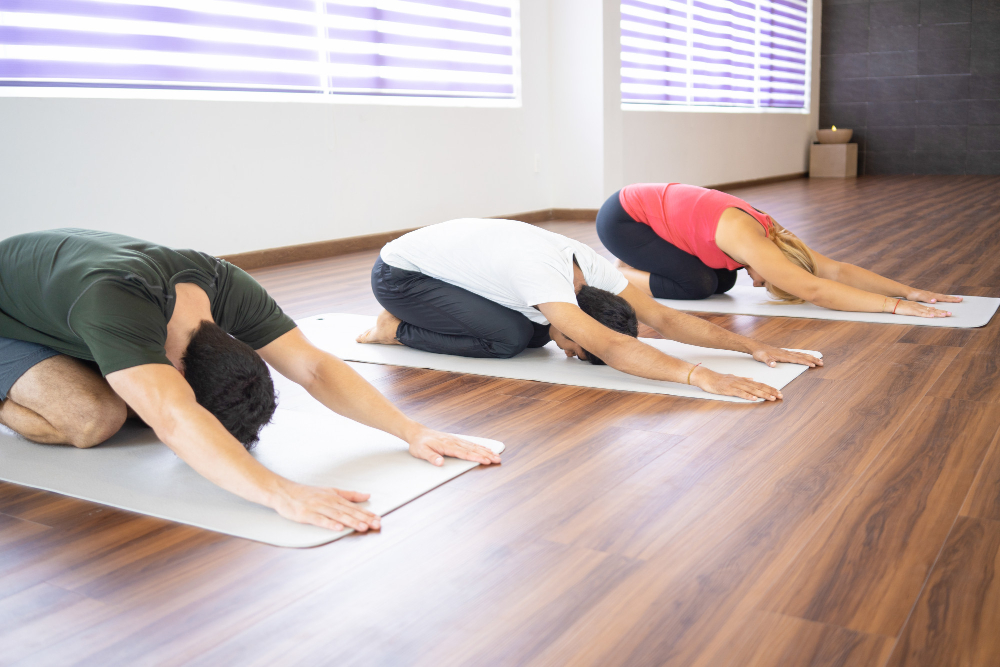Benefits of Balasana
Balasana, also known as Child’s Pose, offers a range of benefits for both the mind and body.
1. Relaxation: Balasana promotes deep relaxation, making it a great pose to practice at the beginning or end of a yoga session.
2. Stretching the back: This pose gently stretches the muscles of the back, helping to alleviate tension and release stress.
3. Lengthening the spine: By folding forward and resting the forehead on the mat, Balasana helps to lengthen the spine and create space between the vertebrae.
4. Calming the mind: Child’s Pose is known for its calming effect on the mind. It can help to reduce anxiety, relieve stress, and promote a sense of inner peace.
5. Improving digestion: The gentle compression of the abdomen in Balasana can help to stimulate digestion and relieve digestive discomfort.
Overall, Balasana is a wonderful pose to practice for relaxation, and stress relief, and to promote a sense of groundedness.
How to Practice Balasana
To practice Balasana, follow these steps:
1. Begin with kneeling on the floor, keeping your knees hip-width apart and your big toes touching.
2. Sit back on your heels and slowly lower your torso down between your thighs, resting your forehead on the mat.
3. Extend your arms forward, placing your palms on the mat or resting them alongside your body with your palms facing up.
4. Close your eyes and take slow, deep breaths, allowing your body to relax and sink into the pose.
5. Hold the pose for as long as feels comfortable, breathing deeply and focusing on releasing tension with each exhale.
To come out of the pose, gently walk your hands back towards your body and slowly roll up to a seated position.
Remember to listen to your body and incorporate changes while practicing the pose as needed. If you have knee or ankle injuries, you can place a blanket or bolster under your buttocks for support.
Variations of Child’s Pose
There are several variations of Child’s Pose that you can explore to find what feels best for your body:
1. Extended Child’s Pose: Instead of resting your forehead on the mat, extend your arms forward as far as you can, stretching your fingertips towards the front of the mat.
2. Wide-Knee Child’s Pose: Start in a kneeling position with your knees wide apart, allowing your torso to rest between your thighs. This variation works more on the hips and inner thighs.
3. Puppy Pose: From a tabletop position, walk your hands forward, keeping your hips stacked over your knees. Lower your chest towards the mat, extending your arms forward. This variation stretches the shoulders and upper back.
4. Supported Child’s Pose: Place a bolster or folded blanket under your torso to provide support and make the pose more comfortable, especially if you have tight hips or lower back pain.
Feel free to experiment with these variations and find the one that works best for your body and goals.
Tips for Beginners
If you’re new to Balasana, keep these tips in mind:
1. Start with a wide-knee variation: If sitting back on your heels is uncomfortable, try practicing the pose with your knees wide apart. This can help to alleviate strain on the knees and ankles.
2. Use props for support: If you have tight hips or lower back pain, place a bolster or folded blanket under your torso to provide support and make the pose more accessible.
3. Focus on your breath: Balasana is a great pose for deep relaxation and stress relief. Remember to focus on your breath, taking slow, deep breaths to calm the mind and release tension.
4. Modify as needed: Listen to your body and modify the pose as needed. If you experience any discomfort or pain, come out of the pose or adjust your position to find a more comfortable variation.

5. Practice regularly: Balasana can be a wonderful addition to your daily yoga routine. Consider practicing this pose at the beginning or end of your practice to promote relaxation and grounding.
If you have any concerns or specific health conditions, consult with a qualified yoga instructor or healthcare professional before attempting new poses.
Incorporating Balasana into Your Routine
Here are a few ways you can incorporate Balasana into your yoga routine:
1. Begin your practice with Balasana: Start your yoga session by practicing Balasana to ground yourself, calm the mind, and set an intention for your practice.
2. Use it as a resting pose: Whenever you need a break during your practice, come into Child’s Pose to rest and restore your energy.
3. Transition between poses: Balasana can be used as a transitional pose between more challenging poses. Take a moment in Child’s Pose to regroup, catch your breath, and prepare for the next pose.
4. End your practice with Balasana: Wind down your yoga session by coming into Balasana for a few minutes.
It is important to listen to your body and adhere to its requirements. Balasana is a versatile pose that can be modified to suit your needs and preferences.


2 thoughts on “Balasana : The Child’s Pose”